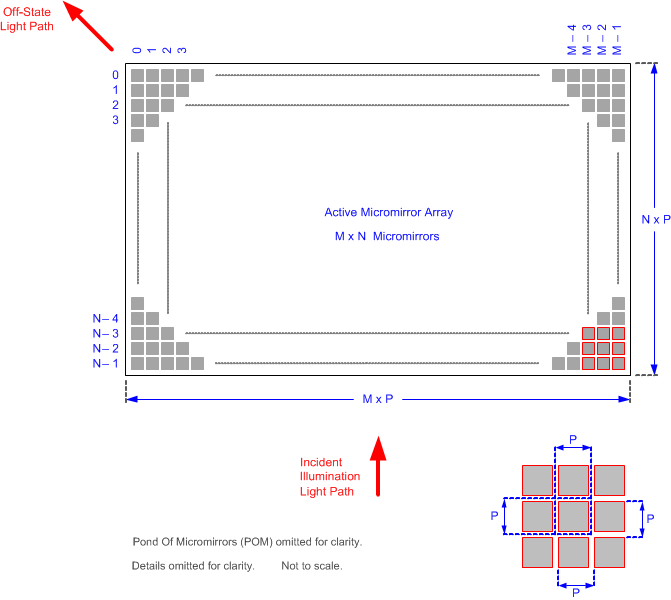DLPS163D April 2019 – December 2023 DLP660TE
PRODUCTION DATA
- 1
- 1 Features
- 2 Applications
- 3 Description
- 4 Pin Configuration and Functions
-
5 Specifications
- 5.1 Absolute Maximum Ratings
- 5.2 Storage Conditions
- 5.3 ESD Ratings
- 5.4 Recommended Operating Conditions
- 5.5 Thermal Information
- 5.6 Electrical Characteristics
- 5.7 Capacitance at Recommended Operating Conditions
- 5.8 Timing Requirements
- 5.9 System Mounting Interface Loads
- 5.10 Micromirror Array Physical Characteristics
- 5.11 Micromirror Array Optical Characteristics
- 5.12 Window Characteristics
- 5.13 Chipset Component Usage Specification
- 6 Detailed Description
- 7 Application and Implementation
- 8 Power Supply Recommendations
- 9 Layout
- 10Device and Documentation Support
- 11Revision History
- 12Mechanical, Packaging, and Orderable Information
Package Options
Mechanical Data (Package|Pins)
- FYG|350
Thermal pad, mechanical data (Package|Pins)
Orderable Information
5.10 Micromirror Array Physical Characteristics
Table 5-2 Micromirror Array Physical
Characteristics
| PARAMETER DESCRIPTION | VALUE | UNIT | |
|---|---|---|---|
| M | Number of active columns (1) | 2716 | micromirrors |
| N | Number of active rows (1) | 1528 | micromirrors |
| P | Micromirror (pixel) pitch (1) | 5.4 | µm |
| Micromirror active array width (1) | Micromirror pitch x number of active columns | 14.67 | mm |
| Micromirror active array height (1) | Micromirror pitch x number of active rows | 8.25 | mm |
| Micromirror active border (Top / Bottom) (2) | Pond of micromirror (POM) | 56 | micromirrors / side |
| Micromirror active border (Right / Left) (2) | Pond of micromirror (POM) | 20 | micromirrors / side |
(1) See Figure 5-8.
(2) The structure and qualities of the border around the active array
includes a band of partially functional micromirrors called the “Pond Of Mirrors” (POM).
These micromirrors
are
prevented from tilting toward the bright or “on” state but still require an electrical
bias to tilt toward “off.”
 Figure 5-8 Micromirror Array
Physical Characteristics
Figure 5-8 Micromirror Array
Physical CharacteristicsRefer to Section 5.10 for M, N, and P specifications.